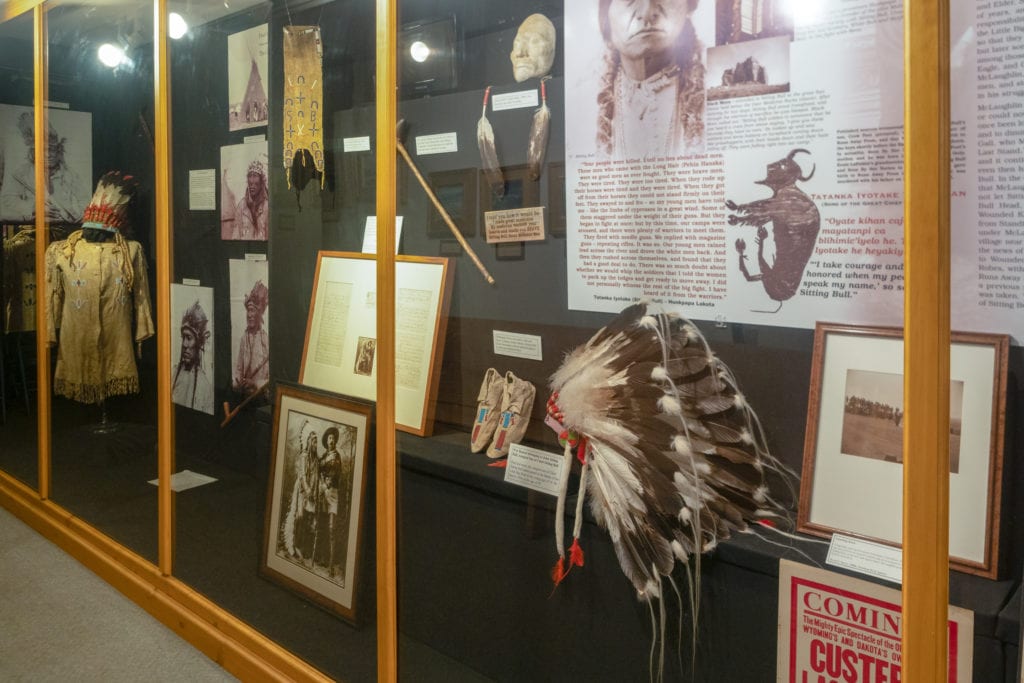I had lived in Billings, Montana for 20 years before I discovered the Tomb of the Unknown Soldier, located an hour southeast in the private town of Garryowen (2012 population: 2). I’d visited similar monuments in Arlington, Virginia, and Pearl Harbor, Hawaii, but I didn’t have to go far from home to pay my respects to one of the first casualties of the Battle of the Little Bighorn.
The battle, which took place on June 25 and 26, 1876, was a rout. Native American warriors outmaneuvered Lieutenant Colonel George Armstrong Custer and his 7th Cavalry; the hundreds of casualties included Custer himself in what has become known as “Custer’s Last Stand.”
Located just five miles from the tomb, the Little Bighorn Battlefield National Monument honors not only Custer, but also the Native Americans who fought to preserve their way of life. Today, a group of white tombstones mark their final resting places atop the rolling hills above the Little Bighorn River; red marble stones mark where Native warriors fell.


On the 125th anniversary of the battle, the Custer Battlefield Museum in Garryowen—which is located within the battlefield—unveiled a new granite Peace Memorial behind the Tomb of the Unknown Soldier. It features a bronze sculpture of Hunkpapa Lakota leader Sitting Bull alongside Custer.
Town for sale
In 1993, Christopher Kortlander bought Garryowen because of its historical significance; he’s since tried to sell the town three times without luck. The privately funded, nonprofit Custer Battlefield Museum is located in the multipurpose town hall building. Steps away from the tomb, the museum is a treasure-trove of artifacts, photographs, and memorabilia. An introductory video attempts to summarize Little Bighorn, a complex battle that continues to be reevaluated by historians.

Download the mobile app to plan on the go.
Share and plan trips with friends while discovering millions of places along your route.
The museum is filled with artifacts from the battlefield, including weapons, beaded leather gauntlets worn by Custer, and intricate Native American garments. Historic photos by David F. Barry, showing Custer, Sitting Bull, and other participants in the battle, line an entire wall. It’s the largest collection of his work on display anywhere in the world.
I’m most moved by a case containing the only certified signature of Sitting Bull. Displayed alongside his leather pipe bag and death mask is a contract he signed with Buffalo Bill’s Wild West Show. Sitting Bull only stayed with the show for three months—he longed to return to his people.




Unknown remains
The Tomb of the Unknown Soldier reportedly contains just that: the remains of a headless man who ended up in a shallow grave near Garryowen, likely during a retreat ordered by his commander, Major Reno. Two eagle buttons on his uniform were the only hints of his identity as a 7th Cavalry soldier. He died from bullet wounds to the hip and shoulder and was decapitated after death.
Just a month shy of the battle’s 50th anniversary, on May 26, 1926, road crews unearthed the remains while excavating a county road. A hatchet burying ceremony had already been planned to commemorate the anniversary; while the unidentified soldier lay in state in Billings, Montana, preparations for a proper military burial were made.
“General Godfrey [who had fought in the battle] and the civilian superintendent of Custer Battlefield got into a pissing match regarding who was going to be in charge of the remains,” says Kortlander. “That’s why he’s buried here.”

With just a month to organize the burial and no time to get permission to bury the unknown soldier at the battlefield’s National Cemetery, Garryowen merchant A.G. Carter and his wife donated land adjacent to their store for the soldier’s grave.
Burying the hatchet
Kortlander shows me photographs taken on June 25, 1926, the day the unknown soldier and hatchet were buried. One shows General Godfrey shaking hands with a Native American chief over the tomb’s marble slab. The chief’s identity is also something of a mystery—he was thought to be Sitting Bull’s nephew, White Bull, but records from an official reporter identify him as Chief Red Tomahawk. In 1890, Red Tomahawk, a policeman, shot Chief Sitting Bull during a botched attempt to arrest the chief and to stop an uprising at South Dakota’s Standing Rock Reservation.
Eyewitness accounts mention 50,000 people—including veterans from both sides of the battle—arriving at Garryowen by train and in Model T Fords to attend the hatchet burying ceremony. An army ambulance carrying the flag-draped coffin, following a riderless horse, carried the unknown soldier’s body from the funeral at Crow Agency six miles to Garryowen. After Chaplain McMurry’s eulogy, pallbearers lowered the coffin as the trumpeter played taps. Today it’s quiet; just me and the bronze busts of Sitting Bull and Custer looking over the tomb.


Before the crypt was sealed, event organizers deposited 19 items inside—including a jeweled 7th Cavalry sword, a letter from Elizabeth Custer, books, and newspaper articles. With a promise for peace, Godfrey buried the hatchet handed to him by the chief. In 1995, the museum placed a marble slab over the tomb with an engraving that reads, “Here Rests In Honored Glory An American Soldier Known But To God.”
If you go
The Tomb of the Unknown Soldier and Custer Battlefield Museum are in Garryowen, Montana, exit 514 off Interstate 90. The museum is open daily except for major holidays. Hours vary by season. Please visit the website for details.







